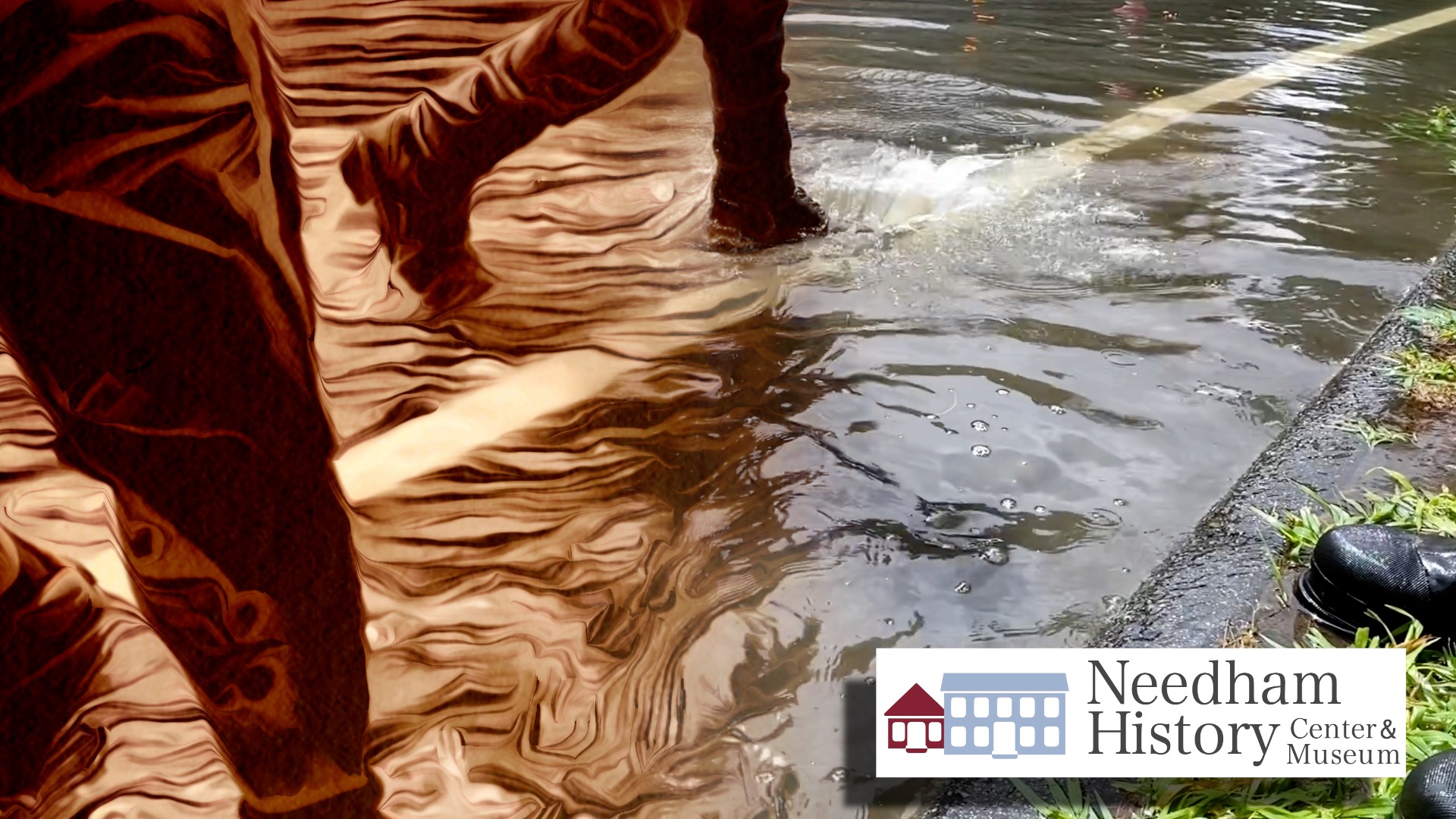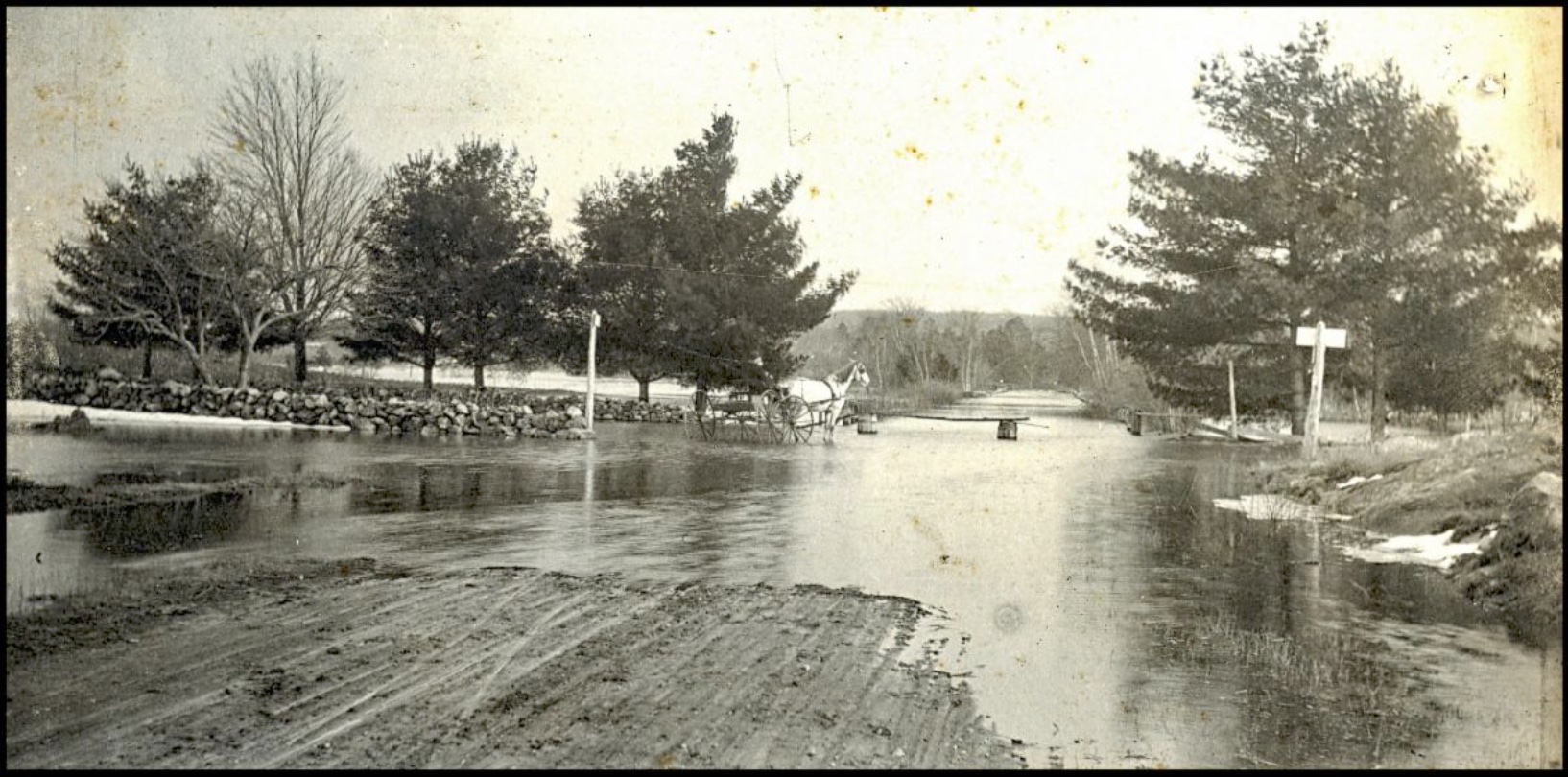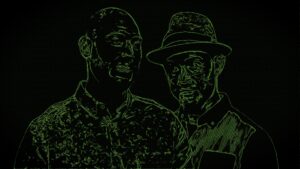
Needham History: It Could Be Worse…
Not much consolation, but true nontheless
 No, that’s not last week, though it looks pretty close! The intersection of South Street and Dedham Avenue in 1886, still flooded by the Charles River. This photo was taken on February 16, five days after the storms had passed.
No, that’s not last week, though it looks pretty close! The intersection of South Street and Dedham Avenue in 1886, still flooded by the Charles River. This photo was taken on February 16, five days after the storms had passed.
It Could Be Worse (It Has Been!)
Oh, my. Almost exactly a year ago, I was writing about a drought so profound that the Charles River had run dry. This week, we are talking about one of the rainiest summers on record since record-keeping began in 1872 – at 15.5 inches, we are at 14th all-time, and bidding fair to crack the top 5 before the season is done. Welcome to New England.
Last Tuesday’s rain event dropped nearly three inches of water on Needham in less than two hours, overwhelming the drainage system and causing basements to flood, businesses to close, and both Rosemary Lake and the Dedham Ave. Reservoir to overflow their banks. Low-lying parking lots on Chestnut Street and Highland Avenue became lakes, submerging the cars parked there. The Charles River gained nearly two feet in depth in a matter of hours, flooding the roads that ran alongside. (See more at Needham Local).
This is the worst flooding we’ve seen in recent years, but Needham is actually quite-flood- prone. The Charles River basin is already low-lying and swampy, and its shallow gradient does not facilitate runoff. In the summer and fall, warm-weather events like hurricanes can dump huge amounts of rainfall very quickly. The hurricane of 1938 dropped around 10-15 inches of rain in this area in a day. And in August 1955 the region suffered the double-hit of Hurricane Connie (4-6 inches, saturating the ground), followed a scant week later by Hurricane Diane, which brought an additional 12-14 inches.
The region also suffers from winter flooding. Unlike hurricanes, which are occasional, the winter floods caused by the combination of snow melt and spring rains are consistent and a regular feature of river towns like Needham, though these days they are usually not harmful. In the past, the winter runoff frequently caused the Charles to wash over its modest bridges and cut off roads, often for weeks at a time. Indeed, the inability to reach Dedham due to annual flooding was one of the reasons listed for creating Needham as a separate town in the Petition of 1711. As late as the 1970s, winter floods were significant and often devastating. Historical Floods of New England, a USGS publication from 1955, lists the known statistics for all of the notable flood years between 1620 and 1955 – 12 years in the 1700s, 46 in the 1800s, and 14 between 1900 and 1955.
Earlier floods are less well documented, but Needham saw major winter floods in 1885, 1886, and 1890. The extent of the 1885 and 1890 floods was more local, but the 1886 flood was widespread, and considered one of the worst to ever impact New England. There was already deep snow on the ground when a 48-hour storm, starting on February 11, dropped 5-8 inches of rain. The rain melted the snow pack, which added to the runoff. The Charles rose to its highest-ever recorded flood levels, and pictures taken even days later show the roads and bridges still under water. Two of Needham’s nine bridges were severely damaged in this flood and had to be rebuilt; and two others – Day’s Bridge (Chestnut Street), and Kendrick’s Bridge (Kendrick Street) – were washed away entirely.
A summer storm in 1938, two months prior to the hurricane, dropped enough rain for the Charles to rise more than 10 inches in a 24-hour period. Public Works crews had to sandbag the water pumping station top prevent it from flooding, and residents were warned to chlorinate their water because of contamination. There was a flood of similar scope in March of 1936, when a pair of back-to-back rainstorms caused the flood waters to reach as far as the town center. The springs of 1967 and 1968 were also bad flood years, with the water inundating the pumping station and threatening to overflow the town’s bridges. For all of these events, there were thankfully no casualties, but damage to homes, businesses, and municipal facilities was considerable.
That many of these floods were not even worse is a testament to one feat of 17th century engineering – the system of drainage canals between Dedham, Needham, and West Roxbury, that includes the Great Ditch (1640s) beside Great Plain Avenue and the Mother Brook (1639), connecting the Charles River in Dedham to the Neponset River in Hyde Park. The Mother Brook is the oldest European-made canal in the United States, and the Great Ditch is not far behind. These canals were dug both the drain the swamps for better grazing, and to shorten up the loopy transit routes along the rivers. In emergencies, they also diverted some of the excess water from the Charles safely into the swamps and other channels.
Modern infrastructure has also helped to manage water control, from municipal drainage systems to the large regional systems managed by the Army Corps of Engineers. In 1910, the Corps built the first Chares River Dam at the mouth of the Charles to manage seasonal flooding; this is the dam that is now under the Museum of Science. It was built in response to the widespread damage caused by the flood of 1886. In 1978, the Corps built the New Charles River Dam, a larger facility than the first one. The New Dam lies beside the Zakim Bridge, just upstream from the Old Dam. The New Dam has pumps that can handle 3.7 million gallons of floodwater per minute. To assist the dam, the Corps also bought up 8100 acres of low-lying land along the river in the Medfield/Millis area, and Dedham/West Roxbury to act as floodplains.
So even in “bad” years we may see localized flooding, but not the widespread damage of past years. I guess that’s some consolation as we survey our flooded basements – it’s been worse?
Flooding in March 1936 reached as far as Needham Center. Crossman’s Market is in the location that was until recently Harvey’s Hardware.
 |
Gloria Polizzotti Greis is the Executive Director of the Needham History Center & Museum. For more information, please see their website at www.needhamhistory.org. |

